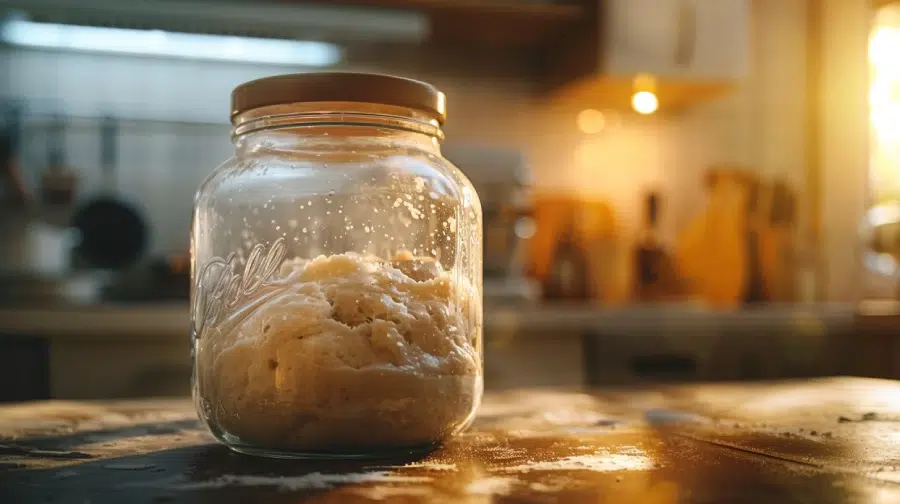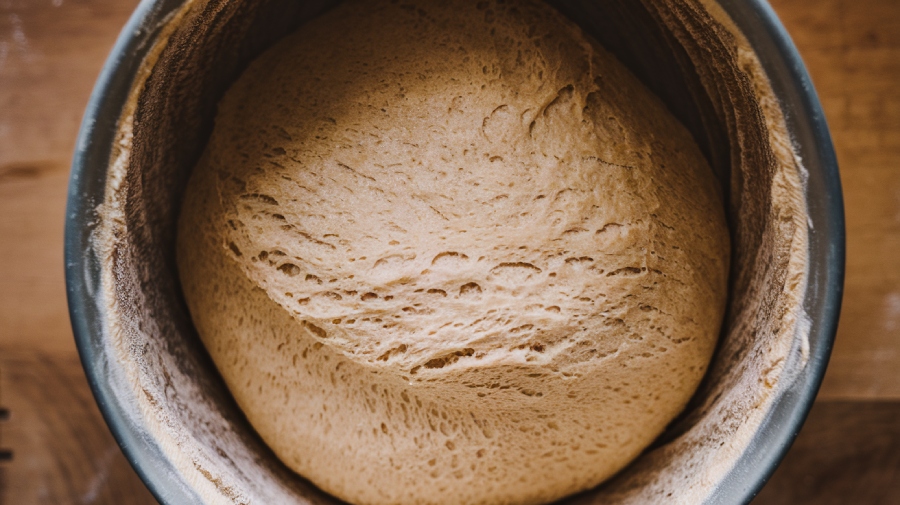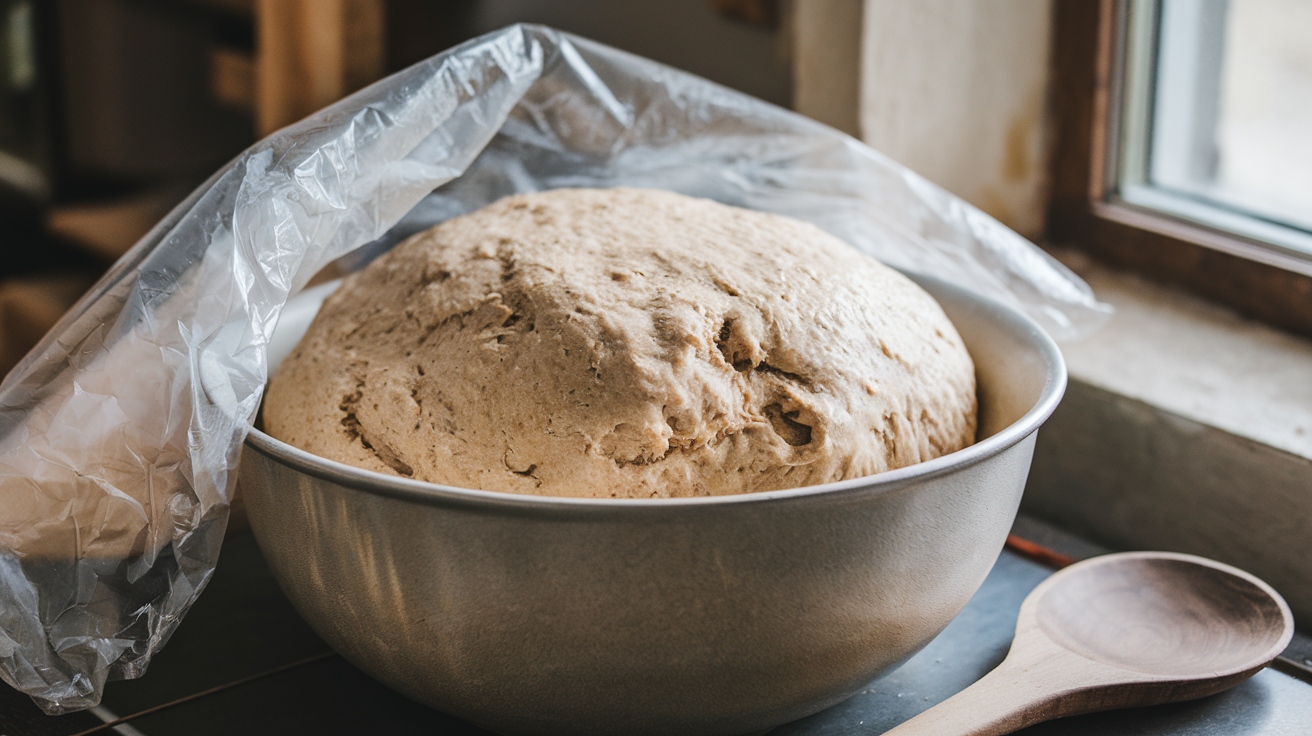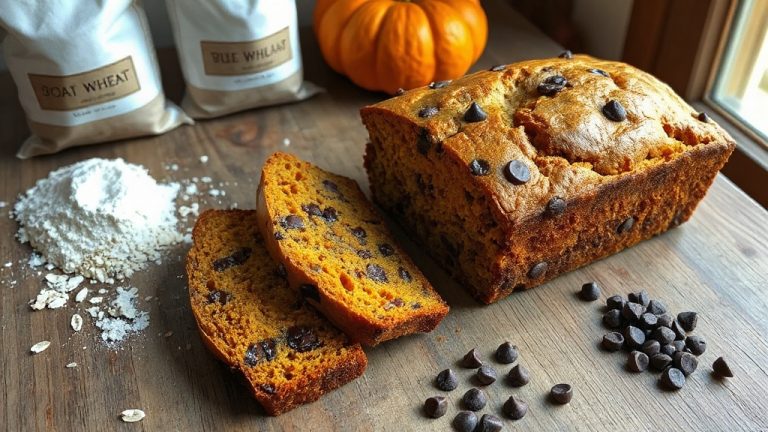Bulk Fermentation Tips for Sourdough: The Secrets
Mastering bulk fermentation is essential for achieving a perfect rise and avoiding over-fermentation in sourdough. Maintain the dough temperature between 74 to 78°F for best yeast and bacterial activity.
Incorporate stretches and folds to guarantee even fermentation. Choose warm fermentation for a quicker rise and lighter crumb or cold fermentation for an extended time and enhanced flavor.
Monitor your dough for volume, domed edges, and gas-trapping capabilities. Regularly check its elasticity and resistance to prevent over-fermentation, maintaining a strong gluten network. Understanding these nuances guarantees your sourdough achieves ideal structure and flavor. Discover more advanced tips on this essential process.
Key Takeaways
- Maintain dough temperature within 74 to 78°F (23 to 25°C) for optimal yeast and bacterial activity.
- Perform stretches and folds during fermentation to ensure even gas distribution and dough strength.
- Monitor dough rise by checking for volume increase, domed edges, and visible air bubbles.
- Choose warm fermentation for quicker rise and lighter crumb; cold fermentation for extended time and enhanced flavor.
- Prevent over-fermentation by observing dough’s elasticity and resistance, avoiding excessive gas bubbles and weak structure.
Bulk Fermentation: Understanding the Process
In sourdough baking, bulk fermentation is the essential first stage, where the dough undergoes significant biochemical changes that are pivotal for developing its structure and flavor profile. During this period, the dough ferments, generating carbon dioxide, which causes it to rise. The bulk fermentation phase is critical for sourdough bread as it ensures the dough develops adequate gluten strength and matured flavors.
Accurate monitoring of dough temperature and rise is crucial. A typical bulk fermentation lasts between 2 to 5 hours, though this can vary based on hydration levels, ambient temperature, and desired outcomes. During this time, you’ll perform stretches and folds to enhance dough strength and structure without overworking it. These actions help redistribute gases within the dough, promoting an even fermentation.
The dough temperature should be consistently monitored to maintain an ideal fermentation environment. This guarantees that the yeast and bacteria activity is balanced, leading to a well-risen dough. Understanding the nuances of bulk fermentation enables you to gauge when the dough has achieved the right volume increase—usually around a 20-50% rise—indicating readiness for the next steps in the sourdough process.
Ideal Temperatures for Fermentation
Maintaining an ideal temperature range of 74 to 78°F (23 to 25°C) during bulk fermentation is important for best yeast and bacterial activity, guaranteeing your sourdough develops the perfect rise and flavor. At these temperatures, both yeast and lactic acid bacteria operate efficiently, balancing fermentation speed and flavor development.
To achieve this, you’ll need to monitor your dough temperature closely. An accurate thermometer is indispensable here. If your kitchen runs cooler, consider using a proofing box or a warm spot to sustain these ideal temperatures. Conversely, if it’s too warm, you can adjust by using cooler water in your dough mix or briefly refrigerating it.
Keep a vigilant eye on your dough’s progress to avoid over-fermentation. Signs of over-fermentation include overly sticky dough and a sour, unpleasant taste. Maintaining the right conditions guarantees that your sourdough bread reaches its best rise without compromising flavor.
Adjusting temperature effectively requires precision. Small changes in ambient temperature can greatly impact your dough’s behavior. Stay proactive in monitoring and adjusting temperature, and you’ll master the art of bulk fermentation, producing consistently excellent sourdough bread.
Warm Vs Cold Fermentation

Understanding the distinct impacts of warm versus cold fermentation is pivotal for mastering the nuances of sourdough bread baking.
Warm fermentation, occurring at 74 to 78°F (23 to 25°C), promotes vigorous yeast and bacterial activity, leading to quicker fermentation times between 2 to 5 hours. This method enhances rise but requires close monitoring to avoid over-fermentation.
On the other hand, cold fermentation, or bulk retarding, involves fermenting dough at 38 to 40°F (3 to 4°C). This technique extends fermentation time to 4 to 24 hours, typically overnight, slowing down yeast and bacterial activity. The slower process enhances flavor development and improves dough handling, making it easier to shape and score.
Consider these key differences:
- Warm Fermentation: Speedy rise, shorter fermentation time, increased yeast activity.
- Cold Fermentation: Extended fermentation time, enhanced flavor development, improved dough handling.
- Texture Impact: Warm fermentation results in a lighter crumb, while cold fermentation yields a chewier texture.
Choosing between warm and cold fermentation depends on your baking goals. Warm fermentation is ideal for quick turnaround, while cold fermentation is perfect for deep flavor and manageable dough. Understanding these methods will help you achieve the desired texture and flavor in your sourdough bread.
Monitoring Fermentation Progress
You need to check your fermentation to make sure it’s going well. Start by considering the impact of the dough temperature on the fermentation stage. Warmer dough ferments faster, while cooler dough takes longer. Your goal is to find an optimal equilibrium.
As you monitor the rising amount, observe the dough’s gas-trapping capabilities. Properly fermented dough will trap gases efficiently, leading to a strong, elastic dough. Look for signs of strength and elasticity; the dough should stretch without tearing and show resilience when poked.
Check for domed edges, a key indicator of appropriate fermentation progress. The dough should have a smooth, rounded surface, suggesting it’s nearing the end of bulk fermentation. Use your intuition and experience—these are invaluable tools in determining the precise moment to proceed.
Adjust the bulk fermentation end based on the dough’s state to avoid over-fermentation. The over-fermented dough becomes slack and loses its ability to trap gases, leading to a dense loaf. By closely monitoring each aspect, from dough temperature to gas retention, you ensure a robust, well-fermented dough ready for the next stage.
How do you get the best dough rise?

The perfect dough rise hinges on keen observation and precise adjustments to fermentation time and temperature. During bulk fermentation, monitoring the dough’s rise is important to achieve the best volume and structure. Adjust the fermentation duration based on the dough temperature and your desired rise percentage. This percentage can vary depending on the recipe and hydration levels, but generally, a rise between 30% and 50% is sought after.
Key dough rise indicators to look for include:
- Domed edges: A slight rounding at the edges of the dough signifies proper expansion.
- Visible air bubbles: These indicate active fermentation, contributing to the dough’s light and airy texture.
- Elasticity and resistance: Test the dough’s strength by gently pressing it; it should spring back slightly.
Achieving the right dough strength and fermentation control is essential to prevent over fermentation, which can ruin the dough’s structure. Over fermentation leads to a weakened gluten network, causing the dough to collapse and lose volume.
Frequently Asked Questions
How to Avoid Over-Fermenting Sourdough?
Sourdough is like delicate clockwork, so don’t over ferment it. Lower hydration levels, shorten room-temperature bulk fermentation and refrigerate both proofing stages. Freeze over fermented dough for future focaccia or pizza.
Should My Sourdough Rise During Bulk Fermentation?
Yes, your sourdough should rise during bulk fermentation. Aim for a 20-50% increase in volume. This rise indicates active yeast and proper gas production, important for developing flavor, structure, and best dough consistency.
What Happens if I Bulk Ferment Sourdough Too Long?
If you bulk ferment sourdough too long, you’ll encounter a collapsed dough structure, overly sour taste, loss of elasticity, and overproofing. This results in sticky, hard-to-handle dough and a dense, unpleasant final loaf.
How Long to Bulk Ferment Sourdough at 80 Degrees?
Bulk ferment sourdough at 80 degrees Fahrenheit for 4 to 6 hours. Monitor dough texture and rise. Adjust fermentation time based on dough development cues to avoid over-fermentation and achieve the best consistency and rise.
Sourdough Perfection with Master Bulk Fermentation
The art of bulk fermentation is like ancient bread-making sorcery. You can always get the perfect rise by balancing the temperatures and watching your dough.
Remember, it’s a dance of precision. Depending on your schedule, you can do either warm fermentation or cold fermentation.
You’ll never have to worry about over-fermentation with these expert techniques.
Have fun baking!







